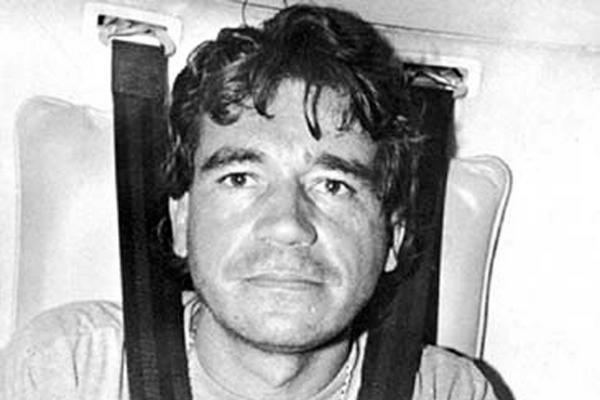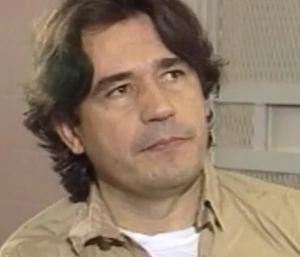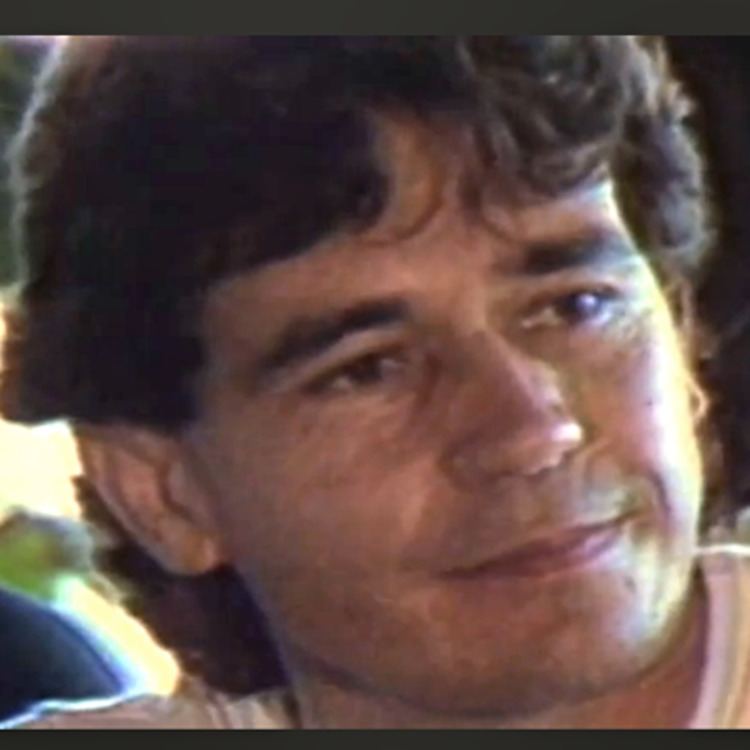Name Carlos Lehder Criminal status Incarcerated Children Monica Lehder | ||
 | ||
Full Name Carlos Enrique Lehder Rivas Occupation Drug trafficker Medellin Cartel Parents Helena Rivas, Willheim Lehder Rivas Similar People | ||
Organizations founded Medellin Cartel | ||
Carlos Lehder and the Birth of the Medellin Cartel
Carlos Enrique Lehder Rivas (born September 7, 1949) is a co-founder of the Medellin Cartel and former Colombian drug lord. He is currently imprisoned in the United States. Born in Armenia, Colombia, Lehder eventually ran a cocaine transport empire on Norman's Cay island, 210 miles (340 km) off the Florida coast in the central Bahamas.
Contents
- Carlos Lehder and the Birth of the Medellin Cartel
- Carlos Lehders home on Normans Cay
- Early life
- Early activities and prison
- Starting his empire
- Normans Cay
- Downfall
- Fugitive capture trial and whereabouts
- Film and television
- References

Lehder was one of the founding members of Muerte a Secuestradores ("MAS"), a paramilitary group whose focus was to retaliate against the kidnappings of cartel members and their families by the guerrillas. His motivation to join the MAS was to retaliate against the M-19 guerrilla movement, which, on November 19 1981, attempted to kidnap him for a ransom; Lehder managed to escape from the kidnappers, though he was shot in the leg. He was one of the most important MAS and Medellin Cartel operators, and is considered to be one of the most important Colombian drug kingpins to have been successfully prosecuted in the United States.

Additionally, Lehder founded "a neo-Nazi political party", the National Latin Movement, whose main function, police said, appeared to be to force Colombia to abrogate its extradition treaty with the United States."

Carlos Lehder's home on Norman's Cay
Early life

Lehder is of mixed German-Colombian descent; his father a German engineer and mother a Colombian schoolteacher. The family owned a semi-legitimate used car business in the Medellín area in which Carlos got his start as a criminal, by supplying it with stolen American cars.
Early activities and prison

Lehder started out as a stolen car dealer, a marijuana dealer, and a smuggler of stolen cars between the U.S. and Canada. While serving a sentence for car theft in federal prison in Danbury, Connecticut, Lehder decided that, upon his release, he would take advantage of the burgeoning market for cocaine in the United States. To that end, he enlisted his prison bunkmate, former marijuana dealer George Jung, as a future partner. Jung had experience flying marijuana to the U.S. from Mexico in small aircraft, staying below radar level, and landing on dry lake beds. Inspired by the idea, Lehder decided to apply the principle to cocaine transport and formed a partnership with Jung. While in prison, Lehder set out to learn as much information as possible that could be useful to him in the cocaine business. He would sometimes even spend hours questioning fellow inmates about money laundering and smuggling. Jung allegedly said that Lehder kept countless files and constantly took notes.

Lehder's ultimate scheme was to revolutionize the cocaine trade by transporting the drug to the United States, using small aircraft.
Starting his empire

After their releases (both were paroled), Lehder and Jung built up a small revenue stream through simple, traditional drug smuggling. Specifically, they enlisted two young American women to take a paid vacation to Antigua, receive cocaine, and carry it back with them to the U.S. in their suitcases. Repeating this process several times, Lehder and Jung soon had enough money for an airplane.
Using a small stolen plane and a professional pilot, the pair began to fly cocaine into the United States via the Bahamas, in the process increasing their financial resources and building connections and trust with Colombian suppliers, while spreading money around among Bahamian government officials for political and judicial protection. Their unconventional method of drug-smuggling began to gain credibility.
Norman's Cay
In the late 1970s, the Lehder-Jung partnership began to diverge, due to some combination of Lehder's megalomania and his secret scheming to secure a personal Bahamian island as an all-purpose headquarters for his operations.
That island was Norman's Cay, which at that point consisted of a marina, a yacht club, approximately 100 private homes, and an air strip. In 1978, Lehder began buying up property and harassing and threatening the island's residents; at one point, a yacht was found drifting off the coast with the corpse of one of its owners aboard. Lehder is estimated to have spent $4.5 million on the island in total.
As Lehder paid or forced the local population to leave, and began to assume total control of the island, Norman's Cay became his lawless private fiefdom. By this time, he had forced Jung out of the operation, and international criminal financier Robert Vesco had allegedly become a partner. Jung used his prior connections to take up a more modest line of independent smuggling for Pablo Escobar and stayed out of Lehder's way.
From 1978 through 1982, the Cay was the Caribbean's main drug smuggling hub, and a tropical hideaway and playground for Lehder and associates. They flew cocaine in from Colombia by jet and then reloaded it into the small aircraft that then distributed it to locations in Georgia, Florida, and the Carolinas. Lehder was believed to have received 1 kilo out of every 4 that was transported through Norman's Cay.
Lehder built a 3,300-foot (1,000 m) runway protected by radar, bodyguards, and Doberman attack dogs for the fleet of aircraft under his command. In the glory days of his operation, 300 kilograms of cocaine would arrive on the island daily, and Lehder's personal wealth mounted into the billions. He accumulated such staggering wealth that on two occasions he offered to pay the Colombian external debt. In 1978, he made an offer to do so to President Alfonso López Michelsen, in exchange for a free space for drug trafficking; in 1982 through Escobar, by then a Colombian Congressman, Lehder did so again, this time in an attempt to prevent his extradition.
Downfall
Their government's approval of the extradition of Colombians encouraged Escobar and Lehder to participate in politics. Lehder founded the National Latino Movement (Movimiento Latino Nacional, in Spanish), which managed three congressional seats and popularized itself by making speeches against extradition.
The April 30, 1984 assassination of Rodrigo Lara Bonilla, the Colombian Minister of Justice, initiated the beginning of the end for Lehder and the Medellín Cartel. Lara had campaigned against the cartel's activities, and his murder marked a change in Colombian politics. President Belisario Betancur, who had previously opposed extraditing any Colombian drug lords to the United States, announced that he was now willing to extradite. Lehder's was the top name on the crackdown list.
Other major Medellín Cartel associates fled to the protection of Manuel Noriega in Panama, but when Pablo Escobar discovered Noriega was plotting to betray him to the U.S. in return for amnesty, the cartel associates then fled to Nicaragua to seek the assistance of Nicaraguan president Daniel Ortega. Escobar had paid some of Noriega's closest colonels to inform him of Noriega's intentions.
Lehder's downfall was assisted by his blatant bribing of Bahamian officials and the attention the activities on Norman's Cay were attracting.
Fugitive, capture, trial, and whereabouts
After Brian Ross's September 5 1983 report, on the U.S. television channel NBC, made public the corruption of Bahamian government leaders, Lehder could not return to Norman's Cay. The government had frozen all his bank accounts and taken over his property and possessions, and he went from being a billionaire to nearly bankrupt. While on the run in the jungle, he got sick with a fever. Escobar sent a helicopter for Lehder and brought him back to Medellín, where he received medical attention to save his life. Even so, he was left very weak. When Lehder recovered, Escobar hired him as a bodyguard.
Eventually, Lehder wanted to rebuild his fortune, but he was captured at a farm he had just established in Colombia, when a new employee of his informed the police of his location. Another theory supported by Jhon Jairo Velásquez, better known as "Popeye", the head assassin of Pablo Escobar, is that fellow members of the Medellín Cartel wanted him out of the picture due to his radical military-like behavior, which they believed would jeopardize their cocaine empire, and so Escobar himself provided Lehder's whereabouts to the police, leading to Lehder's capture.
Having captured one of the Cartel's most powerful members, the U.S. government used him as a source of information about the details of the Cartel's secret empire, which later proved useful in assisting the Colombian government to dismantle the Cartel. In 1987, Lehder was extradited to the United States, where he was tried and sentenced to life without parole, plus an additional 135 years. Now all of the other cartel leaders knew what would happen if they were extradited, and soon afterward, the Medellín Cartel organizations split up. These smaller organizations, especially Escobar's, were later attacked by the Cali Cartel, the Colombian police/army, and soon by the U.S. government, as well. A violent war began as the Medellin Cartel leaders tried to protect themselves by fighting back.
In 1992, in exchange for Lehder's agreement to testify against Manuel Noriega, his sentence was reduced to a total of 55 years. Three years after that, Lehder wrote a letter to a Jacksonville federal district judge, complaining that the government had reneged on a deal to transfer him to a German prison. The letter was construed as a threat against the judge.
Within weeks of sending that letter in the fall of 1995, Lehder was whisked away into the night, according to several protected witnesses at the Mesa Unit in Arizona. While many believe he could have been released, others disagree. Lehder's brother, Federico Guillermo Lehder, who operated on the periphery of the business, might have been mistaken for Carlos, thus causing the reports of Carlos' being free and living overseas.
According to journalist and author Tamara Johnson, who worked on the Lehder defense during the time in question, Lehder was simply transferred to another prison and has continued to be held in WITSEC, the U.S. Bureau of Prisons' version of the federal Witness Protection Program.
Johnson argued that Lehder had not been released, despite Internet rumors to the contrary. Johnson's work on Lehder, titled Norman's Cay: The True Story of Carlos Lehder and the Medellin Cartel, details why the author believes Lehder will never be released: allegedly, Lehder would be privy to secret information regarding the CIA's and his own involvement in the Iran-Contra affair.
Lehder's ongoing legal battles confirm that he remains imprisoned in the U.S. He is not likely to be released anytime soon. On July 22 2005, he appeared in the U.S. Court of Appeals for the 11th Circuit to contest his sentence. Lehder appeared pro se, arguing that the United States failed to carry out its obligations under a cooperation agreement he had entered into with the United States Attorney's Office, after he held up his end of the deal. (United States v. Lehder-Rivas, 136 Fed. Appx. 324; 2005).
In May 2007, he requested the Colombian Supreme Court to order the Colombian government to request his release from the United States because of the violations of his cooperation agreement.
In May 2008, Lehder's lawyer declared to El Tiempo that a habeas corpus petition had been filed, alleging that Lehder's cooperation agreement had been violated and that "a court in Washington" had less than 30 days to respond to the notice.
According to his lawyer, Lehder was transferred to minimum security prison in Florida. He is frequently visited by his family members, and has access to TV and to a computer with only email access. An article published by Cronica Del Quindio in January 2015 reported that Lehder can be released and extradited to Germany at any time.
On June 24 2015, Lehder wrote a letter to the President of Colombia Juan Manuel Santos, in which he requests mediation with the United States to be allowed to return to Colombia.
